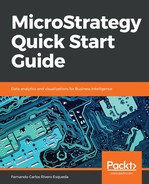Chapter 1, Architecture – Installing and Configuring MicroStrategy, introduces the reader to MicroStrategy, how its technology fits into the business intelligence spectra, and how it satisfies information demands for any organization. MicroStrategy architecture is presented and explained. Client applications, such as Developer and Web, are described, as well as server components. This chapter also describes how to install the MicroStrategy Intelligence Server, as well as the client tools used to build and maintain MicroStrategy Reports and analytics objects.
Chapter 2, Project Design – Creating Your Project Foundation, teaches the reader about MicroStrategy Objects, specifically about Schema Objects, which are used to create an abstraction or model of an analytical database or data warehouse. These objects serve as the foundation for the MicroStrategy Project. Each object is described and explained: what it its main purpose; how to build it, in terms of what its components are; and where it can be reused.
Chapter 3, Basic Reporting – Building Your First Reports, introduces to the reader the Public or Application Objects and how these objects are built from Schema Objects. The first reporting objects, such as Templates, Filters, and Metrics, are described and explained. At the end of the chapter, several Report manipulations are described.
Chapter 4, Advanced Reporting – Interacting with and Improving Your Reports, continues to introduce new Public Objects to the reader; this time, they are objects that will allow them to step up their analysis, flexibility, and performance. Intelligent Cubes are discussed and explained as a way to publish information so that MicroStrategy reporting applications can consume it.
Chapter 5, Dashboarding – Creating Visual Reporting, covers visual information and dashboarding. It shows the reader how to import a data source and then create a Dashboard using Public Objects for enterprise-certified reporting, or to create a web Dashboard using self-service tools.
Chapter 6, Security – Managing Your Users and Their Access, introduces Configuration Objects to the reader, and covers the main security levels in MicroStrategy. Some of these objects allow administrators to set up security profiles and permissions to access objects and to create Users and Groups.
Chapter 7, Administration – Maintaining and Monitoring your Project, expands the knowledge about other Configuration Objects describing those which allow system administrators to perform tasks such as establishing database connectivity and scheduling data refreshes for their Reports and Intelligent Cubes. Then, the main system monitors are presented and described. Finally, three Administrative client tools are described: Object Manager, Command Manager Integrity Manager.
Appendix, Quick Reference Tables by Object Type, is a collection of all the quick reference tables used throughout the book by object type, for readers to reference.
